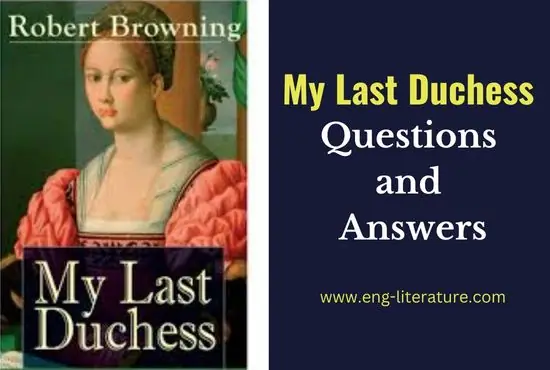My Last Duchess Questions and Answers
- What type of lady was the Duchess? Why was she killed?
Ans. The Duchess was a lady of free and frank disposition. She was very opposite to the manners of her husband. Being a Duke, her husband tried to prevent her from doing common activities. But the lady was easily pleased with anybody else. And she received gifts from her husband as well as common people. It was clear to her husband that he had no special value in the eyes of his wife. Moreover, she had the habit of smiling at everybody. But this was too for the strict Duke to tolerate. So he ordered her to be killed. The Duchess’s humdrum nature was brutally murdered by the Duke.
- What was the nature of the Duke?
Ans. Through the monologue, Browning has given us a chance to survey the character of the Duke. The Duke’s speeches help us to analyse his character. He was a man of autocratic temperament. There was sexual jealousy in him. So, he could not tolerate his wife speaking or smiling at others. Of course he gave a chance to his wife to correct her nature. But when the situation remained unchanged, he killed her by order. Even when he is going to get married for the second time, he informed the envoy that there was no chance of remission in the dowry he demanded. Not only that, but also he expects a full devotion from his 2nd wife and referred to the portrait of Neptune taming the sea horses. Here after, the Duke’s crude and merciless character is exposed.
- What does the last two lines suggest?
Ans. The last two lines are very much significant in the context of the Duke’s proposed second marriage. The picture painted here shows that Neptune, the Sea-God is controlling his horse strictly. It is a rare picture that is pictured by Claus of Innsbruck made for the Duke cast in bronze. But the inner implication is that the Duke is going to tame his second wife without any mercy at all. This is the report which he conveys to the envoy with whom he is speaking.
- What is a dramatic monologue?
Ans. Dramatic monologues are partly dramatic, partly narrative, partly lyrical and partly psychological. And for Browning, they were soul’s tragedies for he said that “My stress lay on the incidents in the development of the soul.” Thus one can say that Browning places abnormal characters in abnormal situations under abnormal crisis for drawing out an abnormal confession, the very essence of his poems.
- What type of a poem is Browning’s ‘My Last Duchess’?
Ans. Robert Browning’s ‘My last Duchess’ is an out and out dramatic monologue which presents the inner world of the Duke and Duchess of Ferrara. It is a beautiful study of the dissection of the soul and presents the Duke in a monologue which brings out the character of the Duke.
- What type of poet was Robert Browning?
Ans. Robert Browning was the typical Victorian poet who was full of optimism. It was his belief that life was a struggle which should be faced head on. Interestingly, Browning was a great believer in God and his power of love.
- Bring out the story on which the poem ‘My Last Duchess’ is based?
Ans. Thanks to Louis S. Friedland, we know that when Browning visited Italy in 1838, he came across a biography of Alfonso II (1533-1598), fifth duke of Ferrara, who married Lucrezia, the 14-year-old daughter of the upstart merchant princes, the Medici, in 1558. As incidents happened, three days after the wedding, Alfonso left her for two years and she died barely 17 years old. Four years later in Innsbruck, Alfonso began negotiating for a new wife with a servant of the then count of Tyrol, one Nikolaus Mardruz.
- When was the poem, ‘My Last Duchess’ published?
Ans. Browning first published the poem in 1842, four years after his visit to Italy.
- What was the original title of the poem and when did Browning change it?
Ans. Browning changed the title in 1849, from “Italy and France. I. Italy” to what it is today.
- What does the title of the poem, ‘My Last Duchess’ refer to?
Ans. The title of the poem evidently refers to a wall-painting that Ferrara reveals to someone yet unidentified in the first fourteen words of the poem.”That’s my last Duchess painted on the wall,” he says.
- What type of a man is the Duke in Browning’s poem, ‘My Last Duchess’?
Ans. In the poem, Browning has presented the Duke of Ferrara as an egotistical,” autocratic and fastidious man. He has a high sense of his own dignity and thus is very arrogant and supercilious. He is typical nobleman representing the Italian Renaissance.
- “That’s my last Duchess painted on the wall,”- Explain
Ans. Though the words of the Duke seem to indicate a painting on the wall, the phrase opens up a plethora of meaning when uttered by the reader. Thus, If the first word “That’s” is stressed then it would seem that Ferrara reduces a woman, once his spouse, to something inanimate, a thing on a wall. Then again if “my” is emphasized, then Ferrara reveals his sense of owning her. A Pause over “last” and one might infer that duchesses, to him, come in sequence, like collectibles that, if necessary, having become obsolescent, are to be replaced. If “Duchess” gets the stress, he implies that he acquires, not just works of art, but persons; and that Duchesses are no different from paintings.
- “I call / That piece a wonder, now.”- Explain
Ans. “That piece” must mean “that portrait,” surely, though there is something intangibly common, almost vulgar, in his expression. Obviously the “piece” is something hand- made, a painting, a wondrous good one and yet Ferrara continues, “there she stands” – probably hinting at the woman.
- “Sir, ’twas not / Her husband’s presence only, called that spot/ Of joy into the Duchess’ cheek” – Explain
Ans. Probably some, “courtesy,” Ferrara asserts, some court compliment to the Duchess aroused the look, that “spot of joy,” that “blush” on the face in the picture. Now, standing before her portrait, where she stands, by the side of a listener made to sit, Ferrara obsessively reviews the reasons why that joy was “a spot,” a contaminant that should not have been on his last Duchess’ cheek.
- “A heart….. too soon made glad…… too easily impressed”- Explain
Ans. May be unable to recognize “courtesy” as insincere, she was made happy by it, in fact, she took joy in “whate’er /She looked on, and her looks went everywhere.” A sprig of flowers from the duke for her bosom and his ancestral name itself meant joy to her, no less than a sunset. Her humility and general good nature, however, disgusted Ferrara for the way they seemed to understate the value of his own gift, a place in a noble family 900 years old.
- What was the gift the Duke had gifted to the Duchess?
Ans. In the poem, the Duke was disgusted at the attitude of the Duchess who could not understand and value his gift – a place in a noble family nine hundred years old.
- Bring out the imagery implied when the Duke says that the Duchess misses the ‘mark’.
Ans. In the poem when the Duke describes her as missing or exceeding the “mark”, he develops his metaphor from archery, as if she was one of his soldiers, competing in a competition for prizes rather than a Duchess who was herself the prize.
- “This grew; I gave commands;/ Then all smiles stopped together. There she stands / As if alive.” – Explain
Ans. This elliptical chain of four curt, bleak sentences brings Ferrara back to where he started. If the Duchess smiled everywhere, could her smiles be stopped by anything short of death by execution? What Ferrara’s commands were, he does not say, but the second time he uses the phrase “As if alive” it has a much more ominous sound. At the beginning, Ferrara could, indeed, be speaking mainly about the “life-like” portrait, but as his anger grew, he shifted to the Duchess herself, she cannot be “life-like.”
- How does the Duke stoop?
Ans.Next Ferrara invites his listener to rise from being seated and “meet/The company below” but ironically when negotiating with the listener’s master the Count for a dowry, Ferrara “stoops.” He not only lowers himself to the level of a mere count but generously offers to “go/Together down” with the listener, a servant, side by side.
- What does Neptune taming a sea horse symbolize?
Ans. In the end of poem, the Duke asks the silent interlocutor to take a look at the bronze metal statue of Neptune, the Sea-God, depicting him as taming a sea- horse. The sculpture is ironic and Neptune in a way symbolizes the Duke who has an uncanny habit of taming wives.
- How does Browning reveal the mind of the Duke?
Ans. Browning develops a new patois, idiolect for the Duke. Ferrara betrays his obsessions by nervous mannerisms. He repeats words associated with the Duchess: the phrases ‘as if … alive”, ‘there she stands’, ‘Will ‘t please you’ and called/calling… that spot of joy’. These tics define his idiolect but also his mind, circling back to the same topic again and again-he takes pride in saying, “I repeat”. He is also obsessive about his height, relative to others. Hence he stands because the Duchess stands on the wall, and he requires his listener to sit, to rise, and to walk downstairs with him side-by-side. He abhors stooping because he would lose face and also needs to control the eyes of others. He curtains off the Duchess’ portrait to prevent her from looking “everywhere” and he tells his listener to look at her and to “Notice Neptune.”

Hello, Viewers! Besides being the Founder and Owner of this website, I am a Government Officer. As a hardcore literary lover, I am pursuing my dream by writing notes and articles related to Literature. Drop me a line anytime, whether it’s about any queries or demands or just to share your well-being. I’d love to hear from you. Thanks for stopping by!

My last duchess summary
All right you will get soon
Critical appreciation / overall summary please